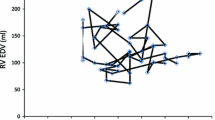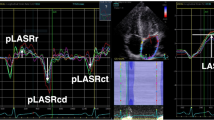Abstract
We evaluated the acute effect of the application of positive end-expiratory pressure (PEEP) on LV diastolic function in 10 healthy subjects. We assessed load dependent diastolic function by Doppler examination of transmitral flow and load independent diastolic function by color M-mode propagation velocity of early flow into the LV cavity (Vp). During the application of PEEP in comparison to the baseline, we found a significant reduction of the E wave peak velocity [79 (64–83) vs. 65 (57–72) cm/s; p = 0.028] and a significant reduction in Vp [84 (73–97) vs. 53 (48–66); p = 0.012]. Moreover, we found a significant reduction in left atrial area [15 (13–18) vs. 12 (10–14) cm2; p = 0.018] and right atrial area [12 (11–15) vs. 11 (9–12) cm2; p = 0.015]. No difference was found in global LV systolic function. The application of PEEP acutely modifies the diastolic flow pattern across the mitral valve, and reduces atrial dimensions.





Similar content being viewed by others
References
American Thoracic Society (2001) International consensus conference in intensive care medicine: non invasive positive pressure ventilation in acute respiratory failure. Am J Respir Crit Care Med 163:283–291
Simonds AK (2002) Nocturnal ventilation in neuromuscular disease—when and how? Monaldi Arch Chest Dis 57:273–276
British Thoracic Society Standards of Care Committee (2002) Non-invasive ventilation in acute respiratory failure. Thorax 57:192–211
Nieminen MS, Bohm M, Cowie MR, ESC Committee for Practice Guideline (CPG) et al (2005) Executive summary of the guidelines on the diagnosis and treatment of acute heart failure: the Task Force on Acute Heart Failure of the European Society of Cardiology. Eur Heart J 26:384–416
Katz JA, Marks JD (1985) Inspiratory work with and without continuous positive airway pressure in patients with acute respiratory failure. Anesthesiology 63:598–607
Naughton MT, Rahman MA, Hara K et al (1995) Effect of continuous positive airway pressure on intrathoracic and left ventricular transmural pressures in patients with congestive heart failure. Circulation 91:1725–1731
Lenique F, Habis M, Lofaso F, Dubois Randé JL, Harf A, Brochard L (1997) Ventilatory and hemodynamic effects of continuous positive airway pressure in left heart failure. Am J Respir Crit Care Med 15:500–505
Chadda K, Annane D, Hart N, Gajdos P, Raphael JC, Lofaso F (2002) Cardiac and respiratory effects of continuous positive airway pressure and non-invasive ventilation in acute cardiac pulmonary edema. Crit Care Med 30:2457–2461
Fessler HR, Brower R, Wise R, Permutt S (1988) Mechanism of reduced LV afterload by systolic and diastolic positive pleural pressure. J Appl Physiol 65:1244–1250
Tkacova R, Liu PP, Naughton MT et al (1997) Effect of continuous positive airway pressure on mitral regurgitant fraction and atrial natriuretic peptide in patients with heart failure. J Am Coll Cardiol 30:739–745
Yoshinaga K, Burwash IG, Leech JA et al (2207) The effects of continuous positive airway pressure on myocardial energetics in patients with heart failure and obstructive sleep apnea. J Am Coll Cardiol 49:450–458
Steiner S, Schannwell CM, Strauer BE (2008) Left ventricular response to continuous positive airway pressure: role of left ventricular geometry. Respiration 76:393–397
Meijburg HW, Visser CA, Wesenhagen H, Westerhof PW, Robles de Medina EO (1994) Transesophageal pulsed-Doppler echocardiographic evaluation of transmitral and pulmonary venous flow during ventilation with positive end-expiratory pressure. Cardiothorac Vasc Anesth 8:386–391
Johnson CB, Beanlands RS, Yoshinaga K, Haddad H, Leech J, de Kemp R, Burwash IG (2008) Acute and chronic effects of continuous positive airway pressure therapy on left ventricular systolic and diastolic function in patients with obstructive sleep apnea and congestive heart failure. Can J Cardiol 24:697–704
Vasan RS, Larson MG, Benjamin EJ et al (1999) Congestive heart failure in subjects with normal versus reduced left ventricular ejection fraction: prevalence and mortality in a population-based cohort. J Am Coll Cardiol 33:1948–1955
Gandhi SK, Powers JC, Nomeir AM et al (2001) The pathogenesis of acute pulmonary edema associated with hypertension. N Engl J Med 344:17–22
Zile MR, Baicu CF, Gaasch WH (2004) Diastolic heart failure: abnormalities in active relaxation and passive stiffness of the left ventricle. N Engl J Med 350:1953–1959
Arques S, Roux E, Ambrosi P et al (2003) Value of Doppler indices of diastolic left ventricular dysfunction in acute cardiac insufficiency. Arch Mal Coeur Vaiss 96:848–853
Navalesi P, Costa R, Ceriana P et al (2007) Non-invasive ventilation in chronic obstructive pulmonary disease patients: helmet versus facial mask. Intensive Care Med 33:74–81
ASE Committee Recommendations (2005) Recommendations for chamber quantification: a report from the American Society of Echocardiography’s Guidelines and Standards Committee and the Chamber Quantification Writing Group, developed in conjunction with the European Association of Echocardiography, a branch of the European Society of Cardiology. J Am Soc Echocardiogr 18:1440–1463
ASE Committee Recommendations (2002) Recommendations for quantification of Doppler echocardiography: a report from the Doppler Quantification Task Force of the Nomenclature and Standards Committee of the American Society of Echocardiography. J Am Soc Echocardiogr 15:167–184
Garcia MJ, Smedira NG, Greenberg NL et al (2000) Color M-mode Doppler flow propagation velocity is a preload insensitive index of left ventricular relaxation: animal and human validation. J Am Coll Cardiol 35:201–208
Ommen SR, Nishimura RA (2003) A clinical approach to the assessment of left ventricular diastolic function by Doppler echocardiography: update 2003. Heart 89:18–23
Bendjelid K, Schutz N, Suter PM et al (2005) Does continuous positive airway pressure by face mask improve patients with acute cardiogenic pulmonary edema due to left ventricular diastolic dysfunction? Chest 128:1891
Lester SJ, Tajik AJ, Nishimura RA, Oh JK, Khandheria BK, Seward JB (2008) Unlocking the mysteries of diastolic function: deciphering the Rosetta Stone 10 years later. J Am Coll Cardiol 51:679–689
Conflict of interest statement
The authors declare that they have no conflict of interest related to the publication of this manuscript.
Author information
Authors and Affiliations
Corresponding author
Additional information
The work was presented in part as an oral communication at the 2004 SMART.
Rights and permissions
About this article
Cite this article
Maestroni, A., Aliberti, S., Amir, O. et al. Acute effects of positive end-expiratory pressure on left ventricle diastolic function in healthy subjects. Intern Emerg Med 4, 249–254 (2009). https://doi.org/10.1007/s11739-009-0255-2
Received:
Accepted:
Published:
Issue Date:
DOI: https://doi.org/10.1007/s11739-009-0255-2




